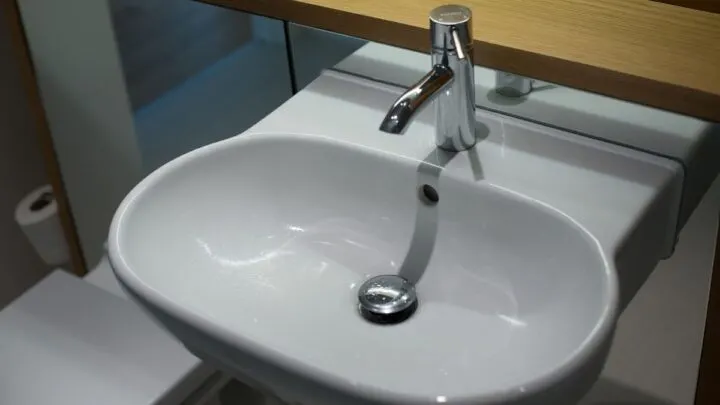The bathroom sink is one of the most used fixtures in a home.
The proper installation of water supply and drain lines in a bathroom ensures that the sink in your bathroom vanity functions properly and that you comply with local residential building requirements.
These lines, when constructed at the proper height, make it simple to connect basins, toilets, and other fixtures that require water.
The normal height for bathroom sink drains generally varies between 18 and 20 inches. Water supply lines are normally installed to the side of the drain line a few inches higher than the line, between 20 and 22 inches above the floor.
The water supply line exits the wall and enters a hole at the rear of the vanity, which is normally 22 to 24 inches above the finished floor.
The sink drain is then only 4 inches away from the water supply pipe. The drainage line for the sink is located 3 to 4 inches below the water supply line within the vanity cabinet.
That might sound like a lot of numbers, but we’ll break it down into further detail later on.
After speaking with various experts within the industry, we have put together this guide to help you answer the above question and understand why it is important to set a standard height for a bathroom sink drain.
What Is The Normal Height for Bathroom Sink Drains?
It is important to mark off the drain and water lines based on industry standards prior to adding a new sink in your bathroom vanity.
The length of the lines and drains is determined by the vanity itself. For example, taller vanities may need longer lines.
Before building water and drain lines, always check local rules and regulations.
Employ a plumber consultant or building inspector who is up to date on the latest plumbing rules and construction requirements.
A sink can be installed in one of two ways. The first is rough-in, and the second is completion, which involves connecting the faucet and sink to the stubs.
The first task necessitates the most plumbing knowledge and expertise. You will have a stress-free sink installation in your bathroom if you can complete this step correctly.
The rough-in system, which is the most common configuration, is used to supply water. Since sinks don’t use a large amount of water, you can use the one to two-inch supply pipes from the shower or tub.
In most cases, the drain line can be connected to the existing one. It’s critical to always vent the sink; otherwise, there would be no appropriate drainage.
The vent lines must originate from the drain and be at least 5 feet away from the trap, and then they must be tied or they will pass through the ceiling.
Normal Height for Bathroom Sink Drains
To comprehend the rough heights of bathroom sink plumbing, you must first realize that sink drain lines should be between 18 and 20 inches long.
The water supply pipes must be a few inches higher than the drain line sides, and they should be 20 to 22 inches from the bathroom or kitchen floor.
Most bathroom sinks are compatible with this height.
There are several options to choose from when it comes to installing a new bathroom sink. You must first decide on the type of sink you desire.
For instance, it could be a vessel or pedestal sink, or something else entirely. Another issue to consider when installing a new sink in your bathroom is the height of the sink.
There is an average height for your sink, but because it is not something we think about on a regular basis, we are likely to neglect it or not even be aware of it.
There are several factors that add to the average bathroom sink height. The normal height for bathroom sinks was established to increase ease and convenience for an individual with an average height to use the sink.
Following the standard measurement makes it simple to accomplish installations and upgrades with minimal effort.
The usual bathroom sink height is little less than 32 inches above the ground. Bathroom vanities, on the other hand, have recently risen in height, although not too much. They are now generally 36 inches above the ground level.
The reason for this is that most households had just one bathroom when the normal height for bathroom sinks was enforced.
However, most homes today have two to three bathrooms, at least one of which is for children who require a countertop and sink in the bathroom as well, albeit one with a lesser height.
Base cabinet manufacturers typically build their items to be around 34.5 inches height along with the 1.5-inch-thick counters above them.
When the two pieces are fastened to one component, the overall standard height is 36 inches.

Factors Influencing Standard Bathroom Sink Height
When it comes to construction requirements, exceptions and deviations are widespread, especially in terms of heights and lengths.
One of the elements affected by non-compliance is the bathroom sink. What happens if the conventional bathroom sink drain height isn’t achieved?
Certain steps have been taken to offer an alternative to the typical bathroom sink height of 32 inches to 36 inches in circumstances where it may not be suitable.
Selection and Installation of a Unique Design
The height of bathroom drains follows the adage “form follows utility” for most home designers.
This means that the overall height of the sink will be determined by the activities that will be performed on the sink and countertop in general.
You may want to go higher with the height to make an impression, especially if you are not dealing with custom-made cabinets. Some people even go as high as 39 inches to achieve that stunning image.
Commercial settings are an excellent example of when unique applications differ from the normal bathroom sink height.
While the standard bathroom height is 36 inches, businesses, industries, and organizations will almost certainly want to make a statement or even a magnificent impression by raising the bathroom sink to 45 inches above the ground.
There are; however, a number of building laws that must be followed, and skilled designers are aware of these regulations.
Bathroom Sink Types
The type of bathroom sink you choose has a significant impact on the overall height. If you’re thinking of a pedestal sink, a bathroom vanity, or a wall-mounted sink, you’ll need to factor in the upkeep before deciding on the best height.
If you choose a vessel sink, however, you must consider the height of the base cabinet or counter as well as the highest point of the sink before calculating the total height.
Physical Requirements
Your bathroom sink must be easy to get to at all times. And this element itself is responsible for a considerable percentage of the variance in bathroom sink height from the standard.
When it comes to the bathroom sink standard height, a person’s physical needs are an important consideration.
Commercial structures typically innovate by giving a different surface, one that is less than the normal height.
Placement of Mirror
Though it may appear that this is something that may be easily neglected, it cannot be. The height of your bathroom sink is mostly determined by the position of your mirror.
There must at least be a 5- to a 10-inch gap between the highest point of the sink and the base of the mirror.
If the bathroom sink is too high, you may not be able to have a clear view and reflection of yourself in the mirror because toiletries on the sink will obstruct your perspective.
Conclusion to Height of Bathroom Sink Drains
This can change depending on the type of bathroom sink you have and what the functions it needs to perform are, but most bathroom sink drains are between 18-20 inches long.
This can even go up to 36 inches if you need a longer drain to reach the height of the sink you desire. Whichever length you need for your sink, it’s important to consult building managers or inspectors to make sure everything is up to code.


